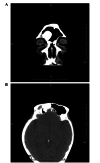Giant osteomas of the ethmoid and frontal sinuses: Clinical characteristics and review of the literature
- PMID: 23759920
- PMCID: PMC3678544
- DOI: 10.3892/ol.2013.1239
Giant osteomas of the ethmoid and frontal sinuses: Clinical characteristics and review of the literature
Abstract
Giant osteomas of the ethmoid and frontal sinuses ary very rare, with only a few dozen cases reported in the literature. Given their rarity, the clinical characteristics and treatment of this disease remain controversial. In this study, the clinical presentation and surgical methods used to treat three patients with giant osteomas of the ethmoid and frontal sinuses are described, combined with a review of the literature from 1975 to 2011. In total, 45 patients with giant osteomas arising from the ethmoid and frontal sinuses (including the present cases) have been reported in 41 articles. Headache and ocular signs are the most common symptoms. This disease often leads to intracranial or intraorbital complications. The main treatment for giant osteoma is surgery via an external approach. The outcome of surgery for giant osteoma is good, with rare recurrence, no malignant transformation and few persistent symptoms.
Keywords: clinical characteristics; ethmoid sinus; frontal sinus; giant osteoma; surgery.
Figures



Similar articles
-
Giant Frontal Sinus Osteomas: Demographic, Clinical Presentation, and Management of 10 Cases.Am J Rhinol Allergy. 2019 Jan;33(1):36-43. doi: 10.1177/1945892418804911. Epub 2018 Oct 11. Am J Rhinol Allergy. 2019. PMID: 30306798
-
A Case of Giant Ethmoid Sinus Osteoma.Cureus. 2021 Sep 16;13(9):e18011. doi: 10.7759/cureus.18011. eCollection 2021 Sep. Cureus. 2021. PMID: 34667686 Free PMC article.
-
Giant ethmoid osteoma originated from the lamina papyracea.Med Arch. 2014 Jun;68(3):209-11. doi: 10.5455/medarh.2014.68.209-211. Epub 2014 May 31. Med Arch. 2014. PMID: 25568536 Free PMC article.
-
Giant fronto-ethmoidal osteoma - selection of an optimal surgical procedure.Braz J Otorhinolaryngol. 2018 Mar-Apr;84(2):232-239. doi: 10.1016/j.bjorl.2017.06.010. Epub 2017 Jul 17. Braz J Otorhinolaryngol. 2018. PMID: 28760714 Free PMC article. Review.
-
Pediatric Benign Paranasal Sinus Osteoneogenic Tumors: A Case Series and Systematic Review of Outcomes, Techniques, and a Multiportal Approach.Am J Rhinol Allergy. 2018 Nov;32(6):465-472. doi: 10.1177/1945892418793475. Epub 2018 Aug 22. Am J Rhinol Allergy. 2018. PMID: 30132339
Cited by
-
Exploring the age and gender-based distribution of paranasal sinus osteomas using cone beam computed tomography: A retrospective cross-sectional study.Heliyon. 2024 Jul 31;10(15):e35222. doi: 10.1016/j.heliyon.2024.e35222. eCollection 2024 Aug 15. Heliyon. 2024. PMID: 39170231 Free PMC article.
-
A Rare Case Report on Suboccipital Region Benign Giant Osteoma.Case Rep Neurol Med. 2016;2016:2096701. doi: 10.1155/2016/2096701. Epub 2016 Mar 9. Case Rep Neurol Med. 2016. PMID: 27051540 Free PMC article.
-
Giant Osteoma of Mandible Causing Dyspnea: A Rare Case Presentation and Review of the Literature.J Maxillofac Oral Surg. 2015 Sep;14(3):836-40. doi: 10.1007/s12663-014-0717-6. Epub 2014 Oct 24. J Maxillofac Oral Surg. 2015. PMID: 26225085 Free PMC article.
-
Frontal sinus giant osteoma with radiologically unusual component suggesting blood supply: A case report.Radiol Case Rep. 2022 Nov 26;18(2):567-571. doi: 10.1016/j.radcr.2022.11.016. eCollection 2023 Feb. Radiol Case Rep. 2022. PMID: 36457794 Free PMC article.
-
Post-Traumatic Peripheral Giant Osteoma in the Frontal Bone.Arch Craniofac Surg. 2017 Dec;18(4):273-276. doi: 10.7181/acfs.2017.18.4.273. Epub 2017 Dec 23. Arch Craniofac Surg. 2017. PMID: 29349054 Free PMC article.
References
-
- Izci Y. Management of the large cranial osteoma: experience with 13 adult patients. Acta Neurochir (Wien) 2005;147:1151–1155. - PubMed
-
- Bignami M, Dallan I, Terranova P, Battaglia P, Miceli S, Castelnuovo P. Frontal sinus osteomas: the window of endonasal endoscopic approach. Rhinology. 2007;45:315–320. - PubMed
-
- Erdogan N, Demir U, Songu M, Ozenler NK, Uluç E, Dirim B. A prospective study of paranasal sinus osteomas in 1889 cases: changing patterns of localization. Laryngoscope. 2009;119:2355–2359. - PubMed
-
- Olumide AA, Fajemisin AA, Adeloye A. Osteoma of the ethmofrontal sinus. Case report. J Neurosurg. 1975;42:343–345. - PubMed
LinkOut - more resources
Full Text Sources
Other Literature Sources
